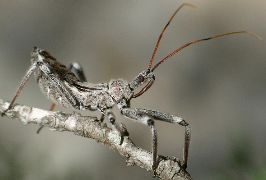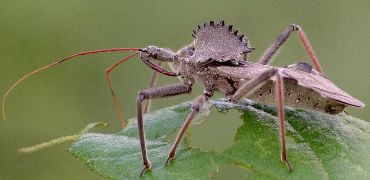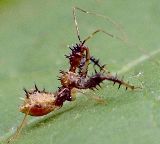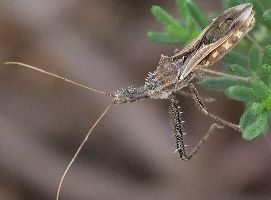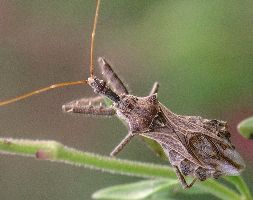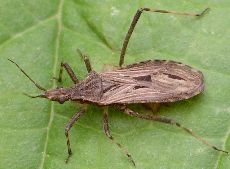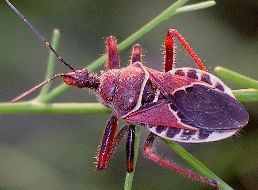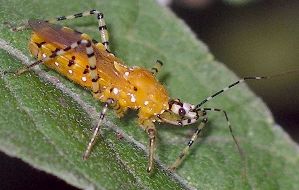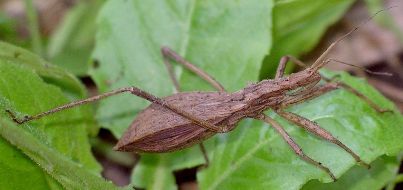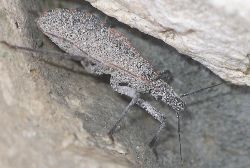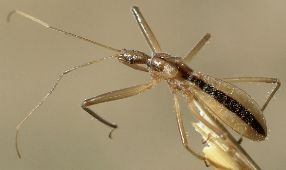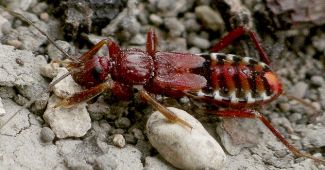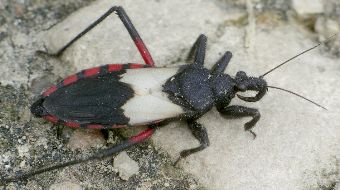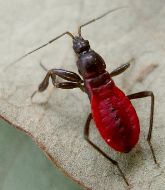
| Reduviidae ~ Assassin Bugs |
page 1 ![]() page 2
page 2
|
There can be no mistaking an adult Wheel Bug (Arilus cristatus). The strange gear-like shape on the back of the pronotum is unique and the insects are usually about 18-20 mm in length. They are a dusty-looking gray color with reddish antennae and legs. They nymphs look a bit like those of Zelus, but they are larger and have a definite constriction at the rear of the pronotum. Their color is also a dusty gray with red highlights. These bugs are large enough to give quite a bite if handled. The puncture they produce feels like a bee sting.
Another unique looking assassin bug is the Thread-legged Bug (Emesaya brevipennis). This species is usually about 30-40 mm in length, but is so slender that it appears to be no more than a thin stick. It is often mistaken for a stick insect, but those belong to a different order, are herbivorous, and do not have predator-like front legs. When threatened, these bugs may hold their front legs out straight in front of their head, making it look like they have only four legs. They can also fly, and it seems amazing that functional wings can actually be folded up so narrow.
The Thread-legged Bugs are capable of catching prey, but they often take an easier route to finding food: they steal insects caught in spider webs. Areas of shrubbery covered with sheet webs of spiders seem to be favorite haunts,
The genus Sinea consists of small brown ambush hunters, often seen on flowers or leaves. The nymphs are extremely spiky and remind me of a Dr. Seuss creature. Adults are relatively spiny, especially their front legs, which have numerous spines, including one that sticks upwards on their front femurs. There are a number of similar species in this genus. For an ambush hunter, Sinea is quite active and I frequently see individuals on the move. They fly readily and move about on vegetation rather quickly.
Species in the genus Diaditus are yet another group of small cryptic brown bugs. These do not even have specialized front legs for helping to catch their prey and they are not particularly fast moving. They probably feast mainly on caterpillars or other sluggish insects. This bug has odd dark markings on the wings that make it look as if they have worn out or parts have been scraped away. They are not damaged - all individuals have the same feature and that's really how they look. This insect also has very short antennae compared to many other assassin bugs.
After discussing brown insects, let's move to the more colorful end of the spectrum. The Red Bee Assassin (Apiomerus spissipes) is a stunning bug, often found flying around flowers in search of its favorite prey, bees. This species sometimes hunts by ambush, but it also actively flies about to better its chances of making a catch. Although it is no longer than 13 mm, the Bee Assassin is a wide and substantial insect, easily noticed with its red, black and white markings.
Sporting gaudy colors works for a number of assassin bugs, and Pselliopus species are decorated to the max. The species we have around here is a deep gold, with black and white bands on the legs and antennae. They are small, at about 9 mm in length, but the colors stand out on green foliage. The nymphs look similar in coloration to the adults.
Stenopoda cinerea is a rather cool looking insect, although it is all brown. It looks just like it were carved out of wood, complete with wood grain and sharply edged corners. Adults are about 16-18 mm in length and wingless. The antennae are very short and the insects are usually found near the ground, in low vegetation. The nymphs have less smooth edges, being a bit "rougher" looking, but they are similar in appearance to the adults.
Triatoma species are the kind of bugs that elicit a morbid curiosity in most people. These are the notorious Kissing Bugs, Mexican Bedbugs, or Blood-sucking Conenoses. Whereas most assassin bugs do not even have one common name, these have several. It is because some members of this genus feed on the blood of humans and can transmit diseases. When they inhabit human abodes, they hide in cracks in the walls and emerge after dark to feed surreptitiously on their hosts. They favor biting around the mouth, which is why they are called Kissing Bugs. Not all species are partial to humans, and they also feed on mice and other small mammals that build nests on the ground. Triatoma species can go for long periods without feeding and then gorge themselves, swelling up in a balloon-like fashion. When they are hungry, they are quite flat. This is a large brown insect with orange markings. It is about 20 mm in length.
The Triatoma nymphs often live alongside the adults, which is quite unusual for assassin bugs, but it is because these do not feed on insects. The bodies of the nymphs are coated with a sticky substance and they are camouflaged with dirt and sand that adheres to them. Their true color is similar to adults.
While not gaudily colored, Fitchia aptera is an attractive and distinctive insect. This 13 mm long assassin bug is a translucent tan color with a brown stripe running down its back. The species name refers to the lack of wings, so it is not surprising that this is a ground dweller. It is rather common when it is present and prefers grassy fields with rocky soil. During the winter it hides under the rocks.
While it's easy to notice the many insects that prefer to hunt on plants and flowers, there are also a number that hunt on the ground. It never hurts to turn rocks or look under fallen logs because some pretty interesting critters can turn up. One such species is Rasahus biguttatus. I've only seen a few of the nymphs and have not yet encountered an adult. The nymphs, though, are quite colorful. They are about 10 mm in length and can give a very nasty bite with their beak. One assassin bug that is quite stunning but rarely seen is Microtomus purcis. At nearly 20 mm in length, it is a good size for an assassin bug, and the red, white, and black colors can't be missed, but it is nocturnal and usually hides during the day under the bark of trees. I happened to see one walking on a road during daylight; that is the only time I've seen this species.
I have only found a single Black Corsair (Melanolestes picipes), and it was probably a nymph, determined by the small size. This species has two color forms: one is all black and one has a red abdomen. The females are wingless (which is why it is hard to tell a nymph from an adult) but the males are strong flyers. The front tibiae are swollen, a shape which helps the insect to hold its prey. |
page 1 ![]() page 2
page 2
![]()
